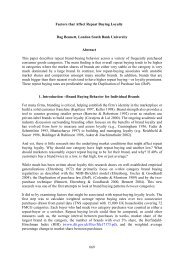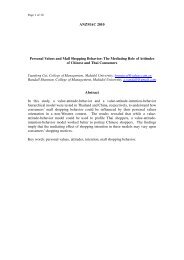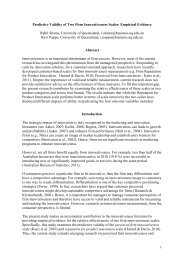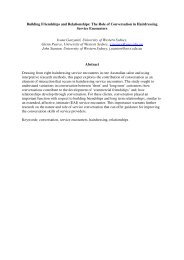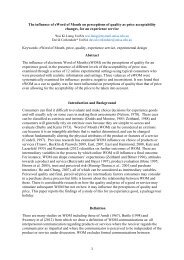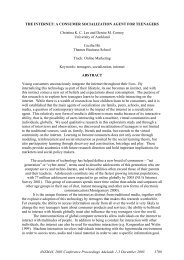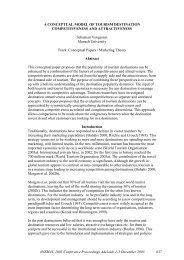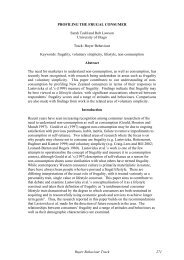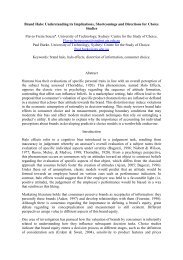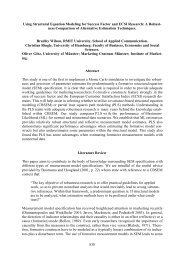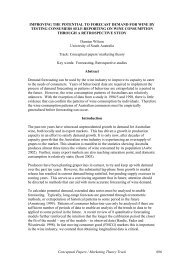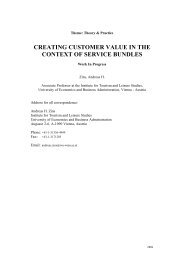amj Australasian Marketing Journal - ANZMAC
amj Australasian Marketing Journal - ANZMAC
amj Australasian Marketing Journal - ANZMAC
Create successful ePaper yourself
Turn your PDF publications into a flip-book with our unique Google optimized e-Paper software.
Fashion Clothing Involvement<br />
are an optimum linear combination forming the latent<br />
construct (Chin, 1998a,b). Therefore, given the theoretical<br />
formulation and the research context (including sampling),<br />
PLS is particularly suitable as a method for analysis and<br />
model evaluation.<br />
The PLS computer program as implemented by Lohm ller<br />
(1981) and further developed by Chin and Fry (2000) was<br />
used to systematically evaluate the properties of the model as<br />
formulated in Figure 1. The results for the structural model<br />
are shown in Figure 2 which depicts all constructs without the<br />
measured variables for clarity. Evaluation of complex models<br />
can not be made on the basis of any single, general fit index<br />
but rather involves multiple indices which are characterized<br />
Gender<br />
Age<br />
-.021<br />
.091**<br />
.024<br />
R 2 .078*<br />
-.259**<br />
R 2 .009*<br />
Selfmonitoring<br />
.109**<br />
Materialism<br />
.498**<br />
.077**<br />
-.225**<br />
.143**<br />
.127**<br />
54 <strong>Australasian</strong> <strong>Marketing</strong> <strong>Journal</strong> 9 (1), 2001<br />
.031<br />
R 2 .263*<br />
Motives<br />
.692**<br />
by many aspects regarding their quality, sufficiency to<br />
explain the data, congruence with substantive expectations,<br />
precision and confidentiality (Lohm ller, 1989 p. 49).<br />
Hence, a systematic examination of a number of fit indices for<br />
predictive relevance of the model is necessary (Fornell and<br />
Cha, 1994; Lohm eller, 1989). As no distributional assumptions<br />
are made these indices provide evidence for the existence<br />
of the relationships rather than a definitive statistical<br />
tests which may be contrary to the philosophy of soft modeling<br />
(Falk and Miller, 1992).<br />
In the hypothesised model the reflective latent variables were<br />
self-monitoring, materialism, and involvement, while motives<br />
were formulated in the formative sense.<br />
R 2 .708*<br />
Fashion<br />
clothing<br />
involvement<br />
Figure 2: Results for hypothesised model<br />
.924**<br />
.944**<br />
Note: Path coefficients are standarised; R 2 indicates variance explained; ** indicates significant path<br />
Fashion<br />
clothing product<br />
involvement<br />
Fashion<br />
clothing purchase<br />
decision<br />
involvement



